We have been up to Dad's allotment today in Marley Hill to plant onions, shallots and garlic. We used the area on bed one where the potatoes had been growing which we harvested last month. Dandelions had taken over. They had taken advantage of the recent mild spell to have a spurt of growth. We dug them out and put them in a bag to ship down to our chicken run. Our hens love dandelions.
We planted a variety of onions called Radar. We bought two pounds of sets a couple of weeks ago. One pound were planted today. The other pound of sets will go onto our own allotment - I rotovated the bed this afternoon ready to plant some time this week.
We planted two varieties of garlic: Early Purple Wight and Bella Italiano. The shallots planted were yellow moon.
These are important crops for us. I am expecting them to be the first out of the ground in the late spring next year, at the end of a lean time for us when many of our stocks of foods will have been used up. Whilst there will be a number of wild leaves we can us then, the onions, garlic and shallots will be welcome additions to our diet.
We grow our own food in a suburban village in the North East of England. Follow us as we keep up the battle to be self-sufficient.
Sunday 30 October 2011
Another 3 hens
We have added to our stock of hens. You may recall that we got three hens in September. Now we have another three. Here they are:
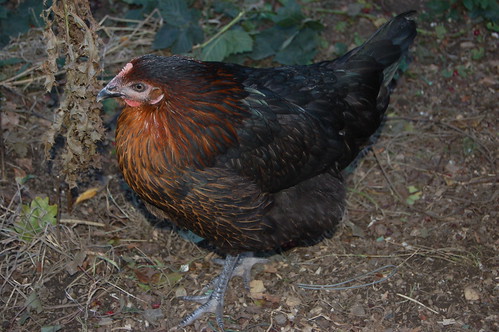
This is Houdini. She's a Copper Black.
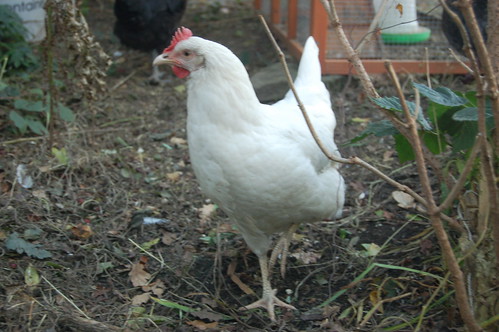
This is Snow White. She is a Coral Nick. Her crest is a bit more developed so we think she may be closer to starting to lay than the other two who came with her.
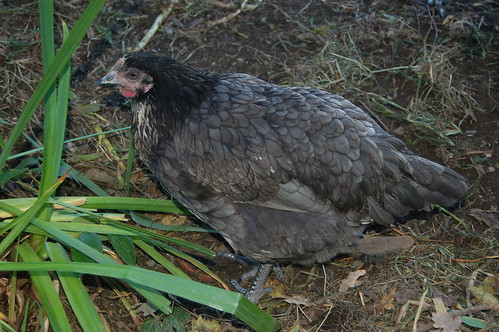
This is Sleepy, a Blue Haze.
At the moment we are still only getting a maximum of two eggs a day. Gingie, our Columbian Black, who we got in September, is still to start laying. We are thinking of waving a roasting tray in her direction in the hope it will encourage her to lay!

This is Houdini. She's a Copper Black.

This is Snow White. She is a Coral Nick. Her crest is a bit more developed so we think she may be closer to starting to lay than the other two who came with her.

This is Sleepy, a Blue Haze.
At the moment we are still only getting a maximum of two eggs a day. Gingie, our Columbian Black, who we got in September, is still to start laying. We are thinking of waving a roasting tray in her direction in the hope it will encourage her to lay!
Thursday 27 October 2011
Signs of spring - in October
The weather this year has been very odd. We started the year with the worst winter for 40 years. The spring was the driest on record for 400 years. The summer was a damp squib. And now, in autumn, the warm spell has resulted in many plants thinking it is spring.
Yellow gorse flowers are a familiar sight in May, not October but I took the following photo just three days ago.
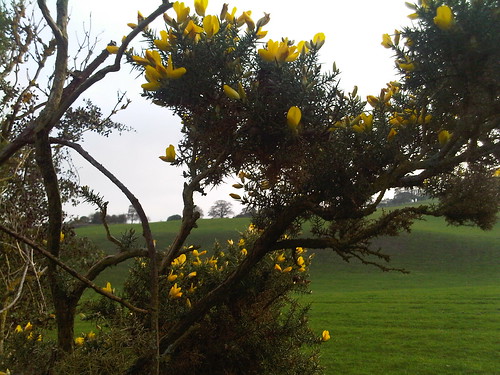
Yarrow flowers in the summer but here it is flowering in Octoer:
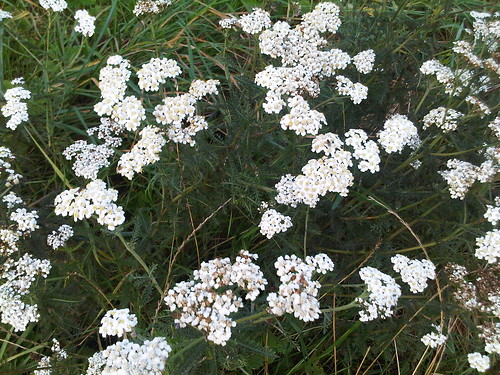
I have also found that nettles, dandelions and other edible weeds are growing. I took a bag with me yesterday to pick the new leaves on the nettles. I steamed them last night and they will go into the freezer shortly. I'm going to pick another batch this afternoon to use in a flan for dinner tonight. We will use our own eggs for this. I've never seen this sort of new growth so late in the year so I'm making the most of it.
In the spring, I make salads from edible wild leaves and flowers. It looks like I'll be able to have an autumn version as well.
One of the other effects of the mild weather is the bees are still active. The hives are still buzzing and the bees seem to be bringing back quite a bit of pollen. That means there are lots of larvae needing to be fed, and that means the queens are still laying. Hive 2 in particular has been very busy. This was the colony we nearly lost a couple of months ago. The queen was missing and had not been replaced by the colony itself. We therefore had to put in a new queen. She is clearly laying. Hopefully, we will have three strong colonies ready to provide us with honey next year.
Yellow gorse flowers are a familiar sight in May, not October but I took the following photo just three days ago.

Yarrow flowers in the summer but here it is flowering in Octoer:

I have also found that nettles, dandelions and other edible weeds are growing. I took a bag with me yesterday to pick the new leaves on the nettles. I steamed them last night and they will go into the freezer shortly. I'm going to pick another batch this afternoon to use in a flan for dinner tonight. We will use our own eggs for this. I've never seen this sort of new growth so late in the year so I'm making the most of it.
In the spring, I make salads from edible wild leaves and flowers. It looks like I'll be able to have an autumn version as well.
One of the other effects of the mild weather is the bees are still active. The hives are still buzzing and the bees seem to be bringing back quite a bit of pollen. That means there are lots of larvae needing to be fed, and that means the queens are still laying. Hive 2 in particular has been very busy. This was the colony we nearly lost a couple of months ago. The queen was missing and had not been replaced by the colony itself. We therefore had to put in a new queen. She is clearly laying. Hopefully, we will have three strong colonies ready to provide us with honey next year.
Tuesday 25 October 2011
Sunflowers and hens
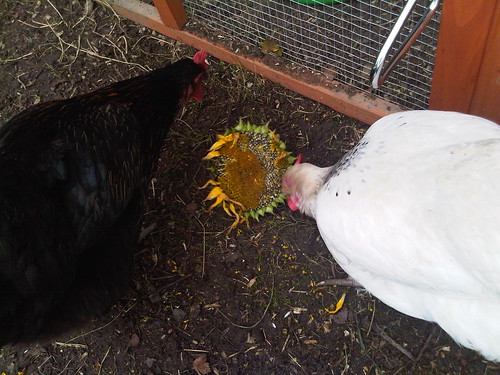
One of the most unexpected wild foods I have found recently was sunflowers. I found them growing next to a public path a couple of weeks ago. I didn't pick any at the time. It seemed a bit early. Yesterday however I decided to revisit the site and see if any were ready for picking. They were. So I picked a bagful and brought them home. They are not for human consumption. They are for the hens.
I took them one flower head yesterday and was disappointed by their lack of interest. When I went back this morning I found it had been picked clean. Success!
Monday 24 October 2011
Egg and chips
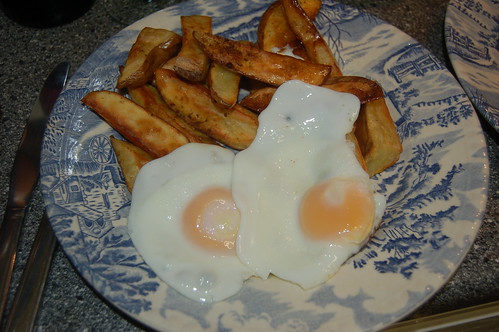
We are still just getting 2 eggs a day (sometimes just one) though we are expecting this to go up once all the hens start laying. Nevertheless, we are getting sufficient eggs to have them on the menu most days. So we have now had our very own self-sufficient egg and chips. We used our own potatoes (cut into chips but roasted) and eggs. Very enjoyable.
Friday 21 October 2011
Local Food Connection
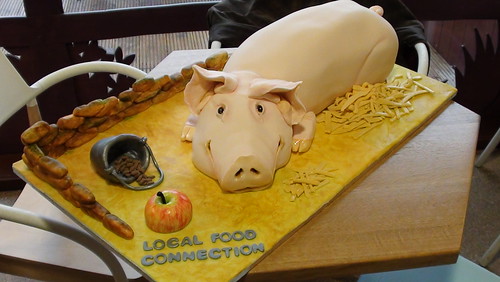
I went to Bill Quay Community Farm in Gateshead this morning for the breakfast launch of Bill Quay Local Food Connection. As a food and social historian and allotment and cookery webcaster, this was clearly going to be of interest to me. The information we were sent explains the project:
Thanks to grant funding from the Big Lottery Local Food Programme, the Farm’s facilities now include a community kitchen, communal eating space and counter for a local food café and farm shop. This distribution and sales hub supports local producers and provides local & regional foods to the community. Along with a programme of inclusive events and activities to engage and educate users the Local Food Connection will offer training experiences and volunteering opportunities for vulnerable adults. Schools and families will be able to use the Connection for educational and recreational purposes.
The Bill Quay Local Food Connection is a new community resource which will make local food accessible, affordable and enjoyable for local people, providing facilities to enable them to taste, buy and cook with local & regional food.
In my opinion, the standardization and mass production of food has led not to a great range of food that a look in a supermarket would suggest is available. Instead, it has led to the loss of local varieties, extra pollution caused by the unnecessary shipping of some foods from thousands of miles away, and an increasing remoteness of food production from the people eating it.
We need to appreciate our food more. That appreciation would increase if we know it is locally produced, rather than churned out of a factory that could be thousands of kilometres away.
So Local Food Connection is getting my full support. I also have a passing interest in Bill Quay Community Farm. I am one of the volunteer beekeepers there. We took some frames of honey off one of the hives a couple of weeks ago. It is now on sale at the farm shop and the proceeds will help support the work of the farm.
Unfortunately we didn't get to try the pig cake, pictured above.
Thursday 20 October 2011
How to pickle onions
We planted onions late on Dad's allotment. The result was that when we picked them recently, they were quite small. They were, however, the right size for pickling. Here's how we pickled ours.
Peel the onions and put in a large bowl. Sprinkle a decent quantity of salt over them and leave for 24 hours, with a tee towel over the bowl. Then rinse the onions and pack them into jars.
To make picking vinegar, put a litre of white wine or cider vinegar into a pan. Add a level tablespoon of black peppercorns, 350g of sugar, a small number of cloves and a sprinkling of powdered mace. Bring to the boil and simmer for one minutes. Then pour into the jars.
Leave the onions for at least 2 weeks before starting to eat them. During that time the vinegar will penetrate the onions.
Tuesday 18 October 2011
Don't wait around to pick the additional growth
The bizarre weather conditions this year have caused some odd growth of some wild foods. In the spring I pick nettles, dandelions and dock. By late summer there are not worth picking. However, I have noticed that there is plenty of new growth of these plants. I suspect this has been caused by the Indian summer we have experienced recently.
I will therefore be going out shortly to pick fresh, green nettle leaves which I will blanch and freeze for winter use. They are a good substitute for spinach. Dock and dandelion are no use for freezing. They are better used as salad leaves.
Don't leave it too long to pick the leaves. A sharp ground frost is expected on Wednesday evening so tomorrow is the best day to do the picking, before Jack Frost gets to work later in the day.
I will therefore be going out shortly to pick fresh, green nettle leaves which I will blanch and freeze for winter use. They are a good substitute for spinach. Dock and dandelion are no use for freezing. They are better used as salad leaves.
Don't leave it too long to pick the leaves. A sharp ground frost is expected on Wednesday evening so tomorrow is the best day to do the picking, before Jack Frost gets to work later in the day.
Monday 17 October 2011
Self-Sufficient in Suburbia - September 2011
This is the latest edition of the programme I make for the Horticultural Channel. It was filmed mainly in September though there were odd bits fromt he end of August and early October.
Tuesday 11 October 2011
How to salt runner beans
We use salting as an alternative to freezing runner beans. This video shows you how to salt them. This is a simple and traditional way of preserving garden produce and is worth a try.
Friday 7 October 2011
How to store onions
There's nothing worse than getting in a good harvest and then finding it's rotted away a few weeks after going into storage. A bit of care avoids this problem. In this video I show you how I store onions, one of our staple crops.
How to make plum chutney
Our plum crop was rather poor this year so we used what was available to make into a chutney. After we made it, we suddenly found we had a glut of plums to deal with as a friend gave us a bag full of them, which we used to make plum and apple jam. Anyway, in this video I show you how to make plum chutney.
Thursday 6 October 2011
Freezing the peas
The pea crop on Dad's allotment was picked recently (we still have to harvest the smaller pea crop from our own allotment). We were very pleased with it as all our previous attempts at growing peas had ended in failure.
Nothing went to waste. The peas were frozen after being blanched for one minute in boiling water. The pea pods were used to make stock and the stalks and leaves were fed to the chickens. Wastenot, want not!
Wednesday 5 October 2011
Hazel picking
Some of you may be aware that I am a local councillor, a role I carry out in addition to my horticultural activities. This afternoon I had a tour of my ward with the leader of Gateshead Council and various officers, as well as my two ward colleagues John and Marilynn. We met them in the car park of the Rose pub, in Streetgate, the next village along from where I live in Sunniside. We were there early and I discovered a hazel tree overhanging the car park. This was too good to miss so John found a carrier bag in his car and whilst he shook the tree, Marilynn and I scurried around like a couple of squirrels collecting the hazel nuts from the ground. We got a good quantity.
After the tour was over, I got out of my suit and into my gardening clothes and headed down the road to Watergate Park where a large number of hazel trees were planted some years ago. A very productive exercise - I gathered a large quantity of hazel. And for good measure, I picked a sack of crab apples in the old Fugar Bar orchard.
If you are into wild food foraging or self-sufficiency, don't leave it any longer to collect the hazel. They are a staple crop for us - high in protein and essential oils. A bit of a super food.
After the tour was over, I got out of my suit and into my gardening clothes and headed down the road to Watergate Park where a large number of hazel trees were planted some years ago. A very productive exercise - I gathered a large quantity of hazel. And for good measure, I picked a sack of crab apples in the old Fugar Bar orchard.
If you are into wild food foraging or self-sufficiency, don't leave it any longer to collect the hazel. They are a staple crop for us - high in protein and essential oils. A bit of a super food.
Subscribe to:
Posts (Atom)